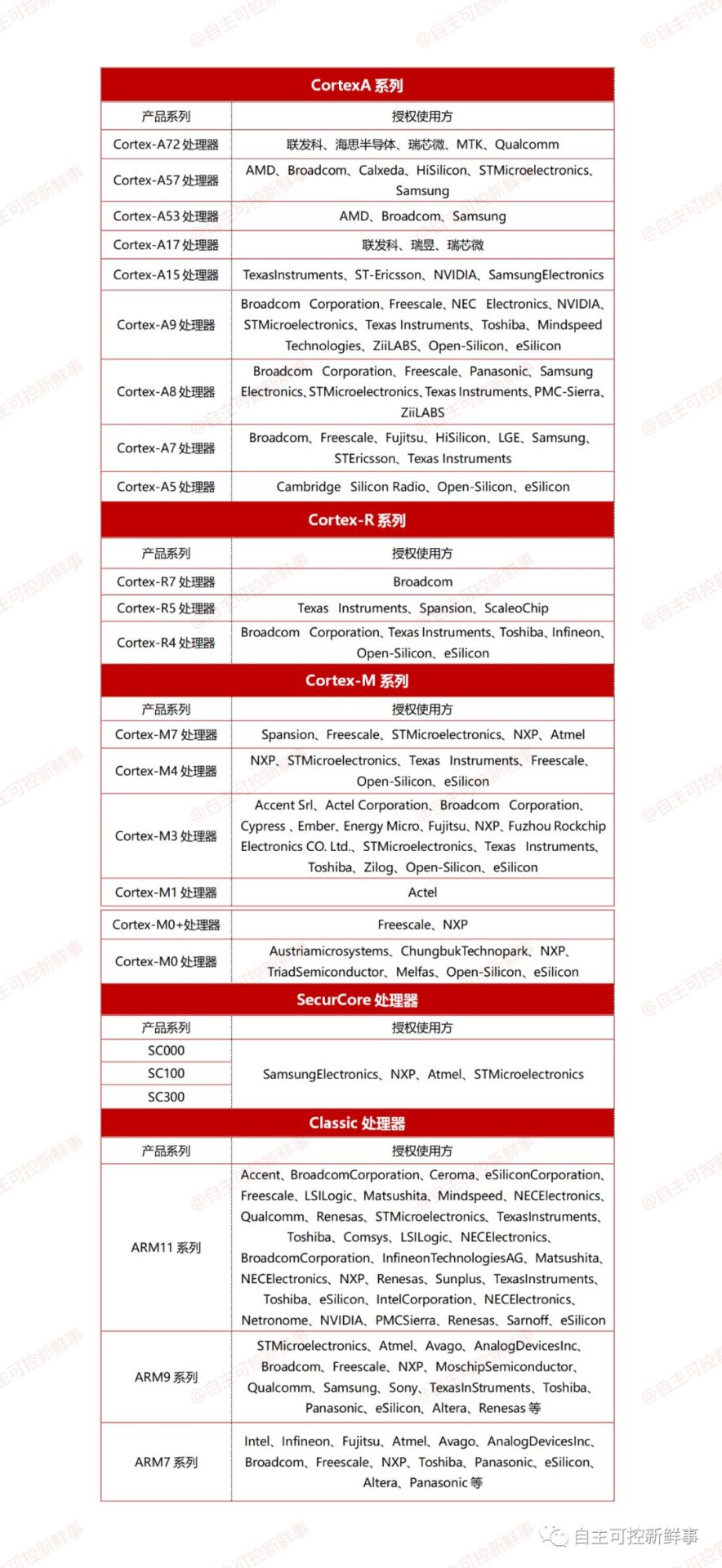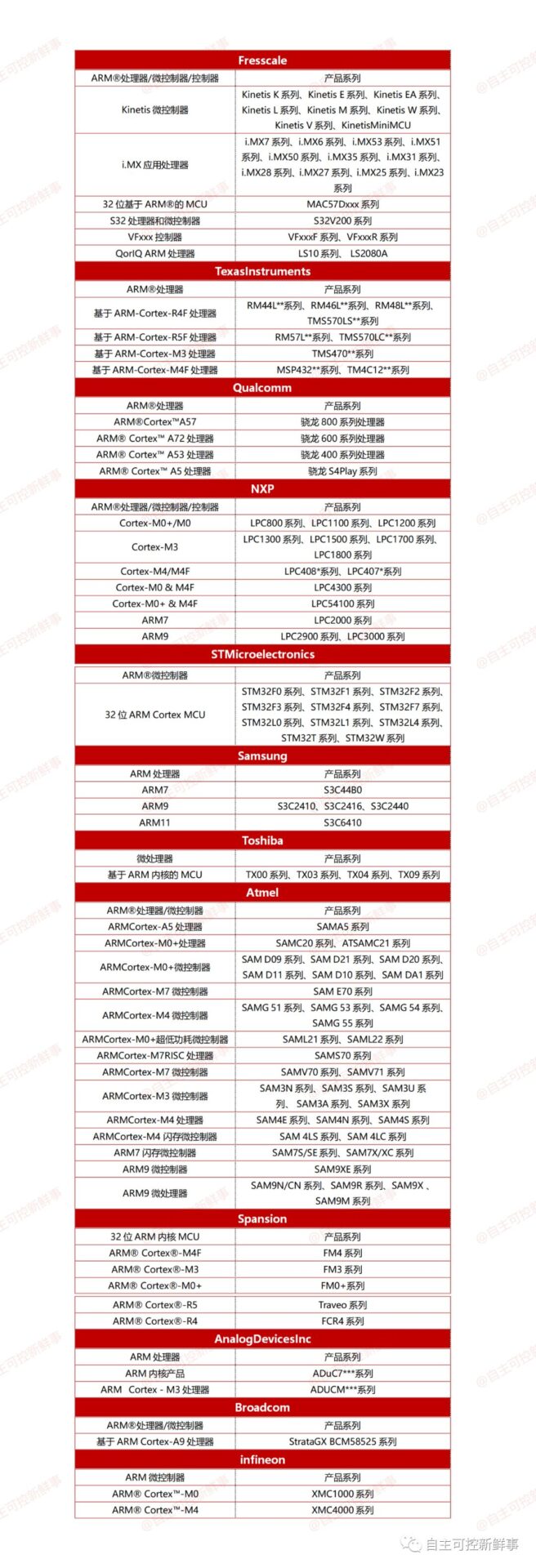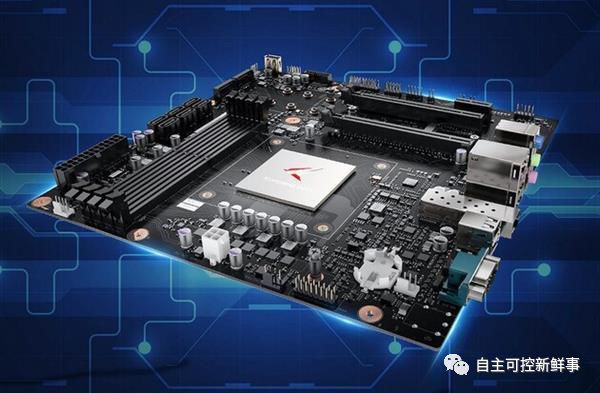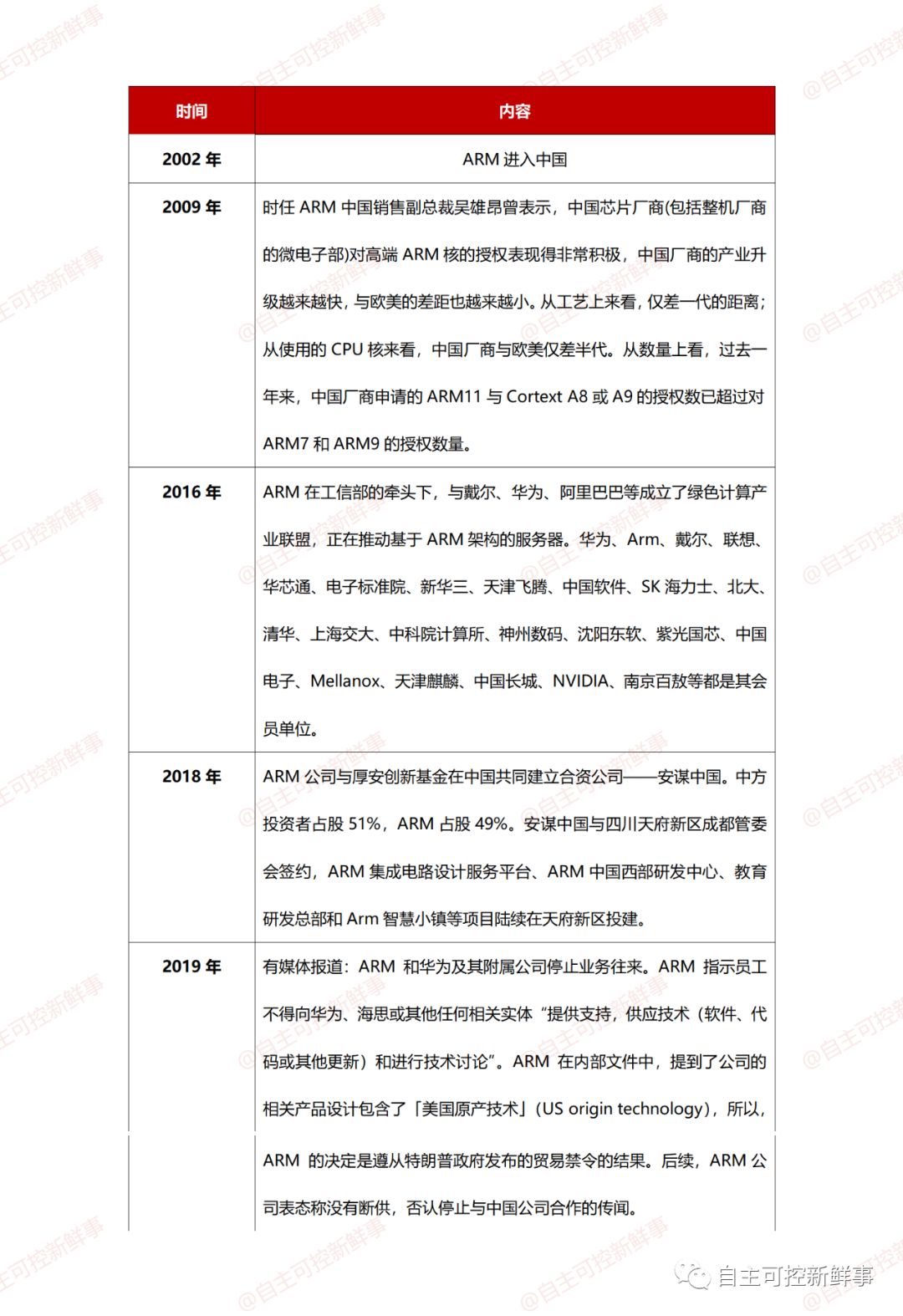Currently,X86 and ARM architectures are recognized as the two most outstanding architectures in the commercialization process. Previously, we introduced the X86 architecture, and today we will introduce another architecture that has been on fire for nearly a decade, ARM.
ARM architecture, formerly known as Advanced RISC Machine (earlier known as: Acorn RISC Machine), is a 32-bit Reduced Instruction Set Computing (RISC) processor architecture that is widely used in embedded system design.Due to its energy-saving characteristics, ARM processors are very suitable for mobile communication fields, aligning with its main design goal of low power consumption.
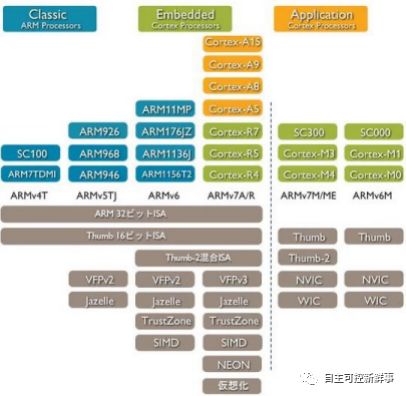
Today, the ARM family accounts for 75% of all 32-bit embedded processors, making it one of the most widely used 32-bit architectures in the world. ARM processors can be seen in many consumer electronic products, from portable devices (PDAs, mobile phones, multimedia players, handheld game consoles, and computers) to computer peripherals (hard drives, desktop routers) and even in military facilities like missile onboard computers. There are also some derivative products based on ARM design, with important products including Marvell’s XScale architecture and Texas Instruments’ OMAP series.To put it bluntly, ARM is equivalent to x86 in the mobile field, with over 95% of mobile devices globally using processors designed with ARM architecture.
The Development History of ARM Company
In 1978, a company called CPU (Cambridge Processor Unit) was founded in Cambridge, England, by an Austrian physicist named Hermann Hauser and a British engineer named Chris Curry.

Hermann Hauser and Chris Curry
After the establishment of CPU, the company mainly engaged in the design and manufacturing of electronic devices. Their first order was to manufacture a microcontroller system for gaming machines. This microcontroller system was developed and named Acorn System 1.
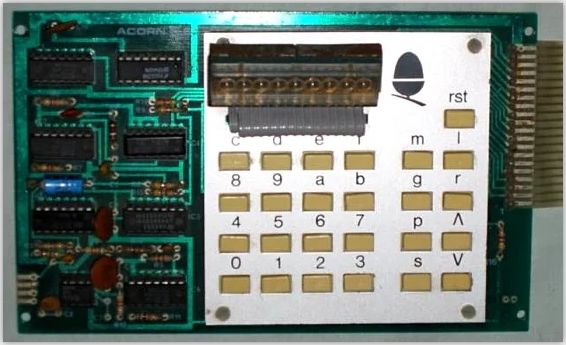
Acorn System 1
In 1979, they changed the company name to Acorn Computer Ltd. After Acorn System 1, they successively developed System 2, 3, 4, and a consumer-oriented cassette computer—Acorn Atom.
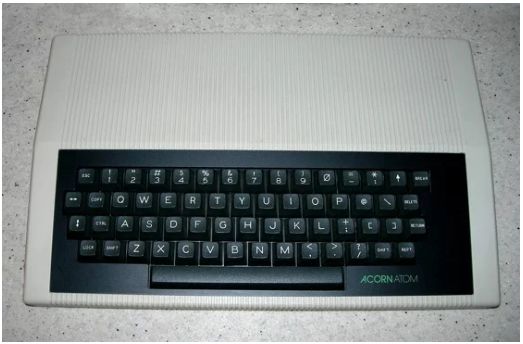
Acorn Atom
By 1981, the company faced a rare opportunity—BBC planned to broadcast a series of programs across the UK to promote computer literacy, and they hoped Acorn could produce a computer to accompany it. However, Acorn lacked suitable chips. At that time, the 16-bit chips from National Semiconductor and Motorola were too expensive, and the then-dominant Intel refused to provide them with design materials and samples for the relevant processor (80286).In frustration, Acorn decided to make their own chips.
Thus, Acorn’s R&D personnel found a study on a new type of processor—Reduced Instruction Set—from the University of California, Berkeley, which happened to meet their design requirements. Based on this, after years of hard work, computer scientists Sophie Wilson and Steve Furber from Cambridge University finally completed the microprocessor design.They named the chip Acorn RISC Machine, which is the origin of the famous acronym “ARM”.

Sophie Wilson and Steve Furber
The former was responsible for instruction set development, while the latter was responsible for chip design.
The first processor chip developed at that time was designated as ARM1. The comparison between ARM1 and Intel’s 80286 processor (commonly known as 286) is as follows:
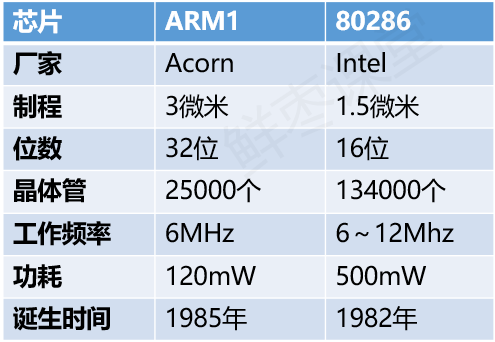
It can be seen that ARM1 and 80286 each have their strengths. However, in the same year, October 1985, Intel released the 80386. In the face of the 80386, ARM1 was completely outmatched.
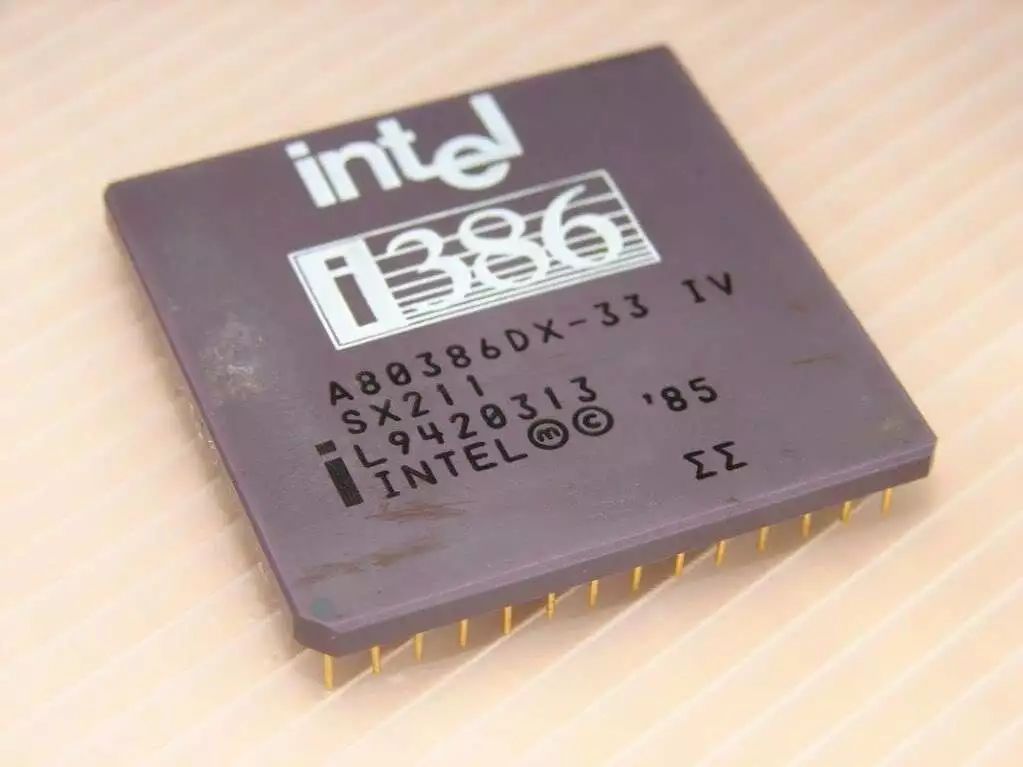
Intel 80386
32-bit, 275,000 transistors, frequency of 12.5MHz, later increased to 33MHz
It is clear that it is unrealistic for ARM to compete directly with the x86 series in terms of performance. ARM intentionally chose a different design route than Intel—while Intel continued to pursue high-performance x86 designs, ARM focused on low-cost, low-power research and development.
The Development History of ARM Architecture
Some people refer to the “Instruction Set Architecture” as architecture, which leads to ARMv8 architecture, ARMv7-A architecture, ARMv6 architecture, etc. These are all RISC instruction sets designed by ARM.
The so-called instruction set architecture is a complete set of reduced instructions launched by ARM, which are the lowest-level commands of a computer. For example, if an application needs to read data from memory, it ultimately achieves memory reading by invoking ARM-designed instructions.

However, some also refer to ARM7, ARM9, ARM11, and Cortex series cores as architectures. For example, the mainstream ARM architectures today include the Cortex-A series architecture in the smartphone field, the Cortex-M series architecture in industrial control embedded fields, and the Cortex-R series architecture for high stability requirements.It is worth mentioning that while the ARM architecture continues to evolve, it maintains compatibility between different versions.
To clearly express the instruction sets used in each ARM application instance, ARM has defined several major versions of the ARM instruction set architecture, denoted by version numbers V1-V8.
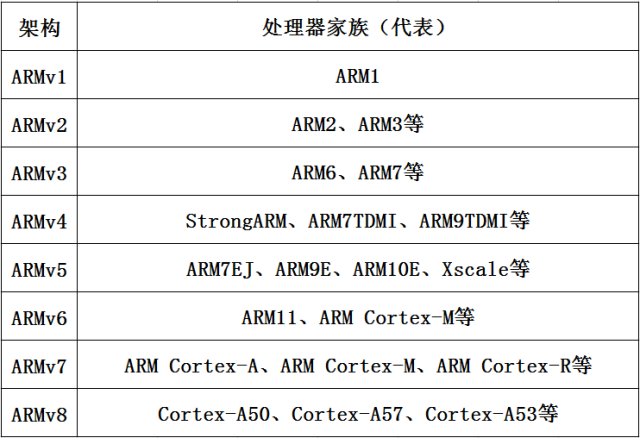
ARMv1 Architecture
In 1985, the ARMv1 architecture was born, and this version of the architecture only appeared in the prototype ARM1, with only a 26-bit addressing space (64MB), and was not used for commercial products.
ARMv2 Architecture
In 1986, the ARMv2 architecture was born, which expanded on V1. The first mass-produced ARM processor ARM2 was based on this architecture, supporting 32-bit multiplication instructions and coprocessor instructions, but still having a 26-bit addressing space. Later variants included ARMv2a, and ARM3 adopted ARMv2a,being the first ARM processor to use Cache.
ARMv3 Architecture
In 1990, the ARMv3 architecture was born. The first microprocessor to adopt the ARMv3 architecture was ARM6 (610) and ARM7. ARM6 served as an IP core, an independent processor, with on-chip cache, MMCU, and write buffer, increasing the addressing space to 32 bits (4GB). Variants included 3G and 3M. Version 3G was not compatible with version 2a, while version 3M introduced signed and unsigned multiplication and multiply-accumulate instructions.
ARMv4 Architecture
In 1993, the ARMv4 architecture was further expanded upon version V3 and is currently the most widely used ARM architecture. ARM7 (7TDMI), ARM8, ARM9 (9TDMI), and Strong ARM all adopted this architecture. In this series, ARM introduced the T variant instruction set, allowing the processor to operate in Thumb mode, adding a 16-bit Thumb instruction set. V4 no longer required compatibility with the 26-bit address space and also clarified which instructions could cause undefined instruction exceptions.
ARMv5 Architecture
In 1998, the ARMv5 architecture was born, adding some new instructions based on version V4. ARM7 (EJ), ARM9 (E), ARM10 (E), and Xscale adopted this architecture, which improved the efficiency of switching between ARM/Thumb modes. New commands included the branch with link and exchange BLX instruction; count leading zeros CLZ instruction; BRK interrupt instruction; and added digital signal processing instructions (V5TE version); more optional instructions for coprocessors. DSP instructions and support for JAVA were also introduced.
ARMv6 Architecture
The V6 architecture was officially released in 2001,first applied in the ARM11 processor.The V6 architecture reduced power consumption while enhancing graphics processing performance. It also introduced a series of new features, including Single Instruction Multiple Data (SIMD) operations. By adding effective SIMD (Single Instruction, Multiple Data) functions for multimedia processing, the processing capabilities for voice and images were improved fourfold compared to the prototype. In addition, a mixed 16-bit/32-bit Thumb-2 instruction set and TrustZone technology were introduced.
ARMv7 Architecture
In 2004, the ARMv7 architecture was born. This version adopted Thumb-2 technology, which was developed based on ARM’s Thumb code compression technology, while maintaining complete code compatibility with existing ARM solutions. Additionally, ARMv7 supported an improved operating environment to accommodate the increasing use of JIT and DAC technologies.
ARMv7 architecture also includes NEON™ technology extensions, which can increase DSP and media processing throughput by up to 400%, providing improved floating-point support to meet the needs of next-generation 3D graphics and games, as well as traditional embedded control applications.
From this point on, ARM renamed its processors to Cortex, with Cortex-M3/4/7, Cortex-R4/5/6/7, Cortex-A8/9/5/7/15/17 all based on this architecture.
ARMv6-M Architecture
In 2007, the ARMv6-M architecture was derived from ARMv6, specifically designed for low-cost, high-performance devices, providing powerful 32-bit solutions to a market previously dominated by 8-bit devices. Cortex-M0/1/0+ adopted this architecture.
ARMv8 Architecture
In 2011, the ARMv8 architecture was born, with Cortex-A32/35/53/57/72/73 adopting this architecture. This was the first ARM architecture to support a 64-bit instruction set.Due to the widespread use of ARM processor cores in many electronic products such as mobile phones, the ARMv8 architecture has received widespread attention as the core technology for the next generation of processors.
ARMv8 was developed on the basis of the 32-bit ARM architecture, mainly used in product areas requiring expanded virtual addresses and 64-bit data processing technology. ARMv8 represents the most significant change in the ARM architecture in nearly 20 years. Its introduction of new features such as Execution State, Exception Level, and Security State has fundamentally changed our understanding of the old ARM architecture.
It can be seen that from the ARMv7 architecture onwards, the naming convention for ARM has changed. The new processor family is named Cortex and divided into three series: Cortex-A, Cortex-R, and Cortex-M.
Cortex-A: Targeted at high-performance computing, such as the Cortex-A76 commonly found in current mobile SoCs.
Cortex-R: Targeted at real-time processing, mainly aimed at embedded real-time processors, commonly found in automotive electronic braking systems, industrial control fields, etc.
Cortex-M: Designed specifically for low-power, low-cost systems. The popular IoT field often sees processors based on the Cortex-M architecture.
In fact, in addition to the three major series mentioned above, there is also a security-focusedCortex-SC series (SC: SecurCore), mainly used for government security chips.
The Establishment of ARM’s Licensing Model
ARM itself does not manufacture or sell CPUs based on its designs but licenses its processor architecture to interested manufacturers.
In 1990, Acorn established a joint venture with Apple called ARM (Advanced RISC Machines) to collaborate. Apple invested £1.5 million, chip manufacturer VLSI invested £250,000, and Acorn itself contributed £1.5 million in intellectual property and 12 engineers.
In the years following its establishment, ARM’s performance was mediocre, and engineers were anxious about potential layoffs. In this situation, ARM decided to change their product strategy—they stopped producing chips and instead licensed their chip design solutions to other companies, adopting a “Partnership” open model. Unexpectedly, this model opened a new era for ARM.
ARM adopted an IP licensing business model, charging a one-time technology licensing fee and royalty commissions.Specifically, ARM has three licensing methods: usage-level licensing, core-level licensing, and architecture-level licensing. These three levels of permissions are sequentially increasing.
Usage-level licensing is the most basic and lowest level of licensing. This means you can only use predefined IP provided by others in your design, cannot modify the IP, nor create your own encapsulated products based on that IP. Users with usage licenses can only purchase pre-packaged ARM processor cores, and if they want to implement more functions and features, they can only do so by adding DSP cores outside the package (of course, they can also do so through repackaging methods). Due to concerns about insufficient protection of intellectual property rights, ARM applies this level of licensing to many companies with Chinese backgrounds.
Core-level licensing allows for building upon a core and adding your own peripherals without changing the original design, but adjustments to product frequency, power consumption, etc., can be made according to needs. For example, USART, GPIO, SPI, ADC, etc., ultimately forming their own MCU, such as Samsung, Texas Instruments (TI), Broadcom, Freescale, Fujitsu, and Calxeda, these companies do not have the authority to modify the core.
Architecture-level licensing allows ARM to authorize partner manufacturers to use its architecture, and they can make significant modifications to the ARM architecture, even extend or reduce the ARM instruction set, facilitating their design of processors according to their needs. For example, Qualcomm’s Krait architecture and Apple’s Swift architecture were designed based on their needs after obtaining ARM’s authorization.
To illustrate with a metaphor: suppose I wrote an article, and I only authorized you to repost it without modifications, that is usage-level licensing; I authorized you to quote my article in yours, that is core-level licensing; I authorized you to modify and reorganize my article to form a new paper, that is architecture-level licensing.
Note that the architecture-level licensing for a specific version is usually permanent.
If we further classify based on usage, ARM’s licensing model also includes, for example, academic licensing, which is free for universities and research institutions; for instance, Design Start is a licensing model designed to help semiconductor companies quickly and cheaply understand ARM IP with low cost and low risk; chips designed under these two models cannot be sold and can only be used for internal research.
There are alsomulti-purpose licensing and lifetime multi-purpose licensing, which are divided based on the duration of licensing effectiveness, relatively suitable for large enterprises. Whilesingle-purpose licensing divides the licensing effectiveness based on purpose, this licensing model requires an upfront licensing fee, followed by approximately 2% royalty per chip. This licensing is more suitable for startups or specific design projects with clear objectives.
It is precisely ARM’s licensing model that has greatly reduced its R&D costs and risks. It has formed an ecosystem centered around ARM through a model of shared risks and shared benefits, making low-cost innovation possible. Currently, ARM has about 1,000 licensing partners worldwide and more than 300 partners, but only 15 companies dare to purchase architecture licensing. Qualcomm’s Krait, Apple’s Swift, and Marvell are typical users. Thanks to the support of such a large number of licensing partners, ARM processors have achieved a quarterly shipment of 2.5 billion units, with a historical total of 50 billion units, enough to circle the globe 12 times.
Products Based on ARM Processors/Microcontrollers Include:
ARM saw the burgeoning market potential in China and entered the country in 2002, working with Chinese partners to build the ARM ecosystem. To enter the Chinese market, ARM provides tailored services to Chinese manufacturers, helping them to apply for ARM licenses faster and cheaper. For example, in China, they implemented a strategy called “IP Access,” where users only need to pay a certain licensing fee to choose the ARM cores they need from a variety of products. If they find a core unsuitable, they can switch to another even after development has started.
According to ARM’s public information, as of now, ARM has over 200 partners in China, and the cumulative shipment of domestic SoCs (system-on-chips) based on ARM technology exceeds 16 billion units. Currently, 95% of domestic chips are based on ARM technology. Many chips designed by ARM’s Chinese partners have already taken leading positions in global applications such as IoT, mobile, and even cloud servers, becoming an innovative driving force that cannot be ignored in the global semiconductor market.
ARM has monopolized the mobile chip market and is gradually entering the PC market. Based on this architecture, establishing a server chip ecosystem will be relatively easy, thus receiving the most attention. Currently, domestic server chip companies such asFeiteng andHuawei are developing server chips based on ARM architecture.
Among them, Huawei is progressing the fastest and is the most powerful, with a relatively complete industrial chain, independently developing the ARM core architecture, while also developing server products based on its own ARM architecture server chips, planning to combine it with the Huawei cloud computing it promotes.
Currently, Huawei’s ARM architecture server-related products include three main lines: Hi16 series CPU, Kunpeng series ARM CPU, and Taishan servers. In 2004, Huawei began developing ARM architecture-related chips, covering multiple product lines. In 2019, it launched its self-developed Kunpeng 920 series high-performance processors, with up to 64 cores for the server version and 4-core and 8-core versions for the desktop.
From the perspective of deployment and business progress based on ARM architecture, Tianjin Feiteng has developed earlier, and its product line layout, commercialization, and ecology are doing well. Currently, it has cooperated with more than 400 domestic software and hardware manufacturers, initially establishing a relatively complete ecosystem.
Feiteng processors were born in 1999, and the team size has grown from a dozen to over 500 people. The chip scale has grown from hundreds of thousands of transistors to hundreds of billions of transistors, and the process technology has evolved from 0.35 microns to 16/14 nanometers, forming a complete high-performance CPU product line covering servers, desktops, laptops, and embedded systems. For example, the FT-2000+/64 processor chip is aimed at enterprise-level high-performance servers.It should be noted that like Huawei, Feiteng has also obtained permanent authorization for the ARM instruction set architecture, and its core is also independently designed.
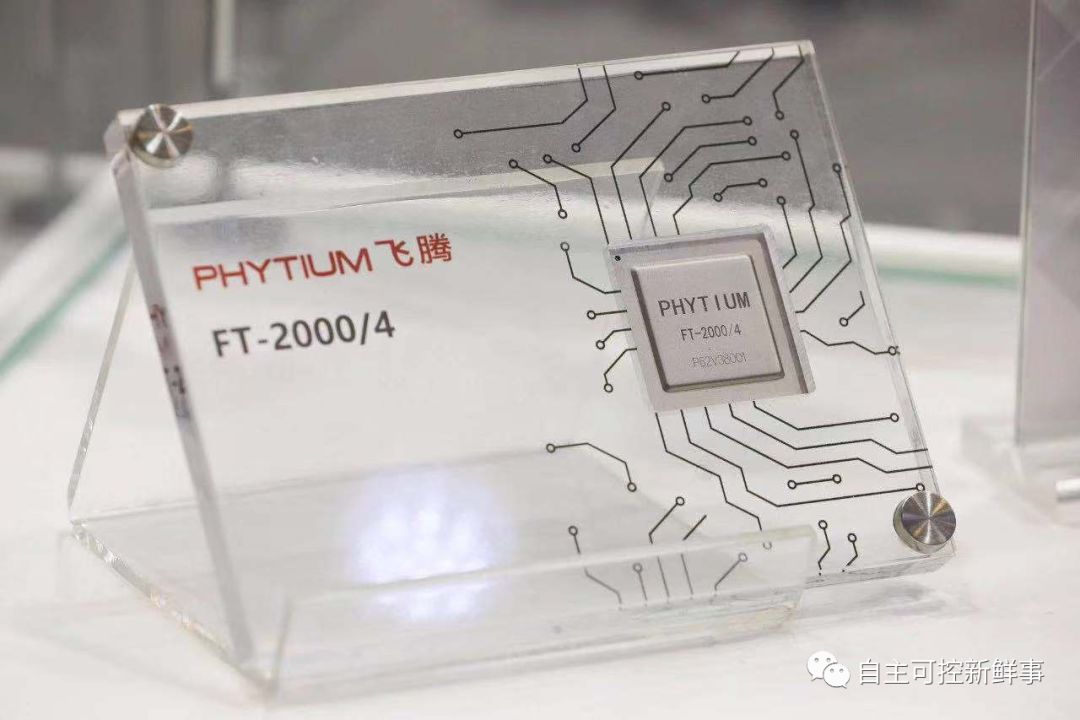 According to ARM’s latest plan, ARM aims to achieve a shipment volume of 100 billion chips in four years (2017 + 2018 + 2019 + 2020) (the previous 100 billion took 26 years), and then strive for 1 trillion. The five major directions it targets, in addition to mobile computing, automotive electronics, embedded chips, and consumer electronics where ARM architecture has already gained an advantage, also include internet and server infrastructure. Therefore, in the overall environment where global commercialization and market openness are continuously increasing, there is no need to worry about the limitation of ARM server manufacturers’ licenses.
In addition, manufacturers that obtain ARM instruction set licenses not only have the greatest freedom in designing cores and SoC chips but can also propose modifications or additions to the ARM instruction set based on market demand, making the development of the ARM instruction set open. As the market share of domestic manufacturers such as Feiteng, Huawei, and Zhanxun continues to increase, their influence over the development of the ARM instruction set will gradually grow, achieving influence over higher-level IP through market success.
Based on the open ARM chip IP licensing, numerous manufacturers have participated in the formulation of ARM server architecture standards. In April 2016, in the Chinese market, ARM, under the leadership of the Ministry of Industry and Information Technology, established the Green Computing Industry Alliance with Dell, Huawei, Alibaba, and others, promoting servers based on ARM architecture. Members include Huawei, ARM, Dell, Lenovo, Huaxin Tong, Electronic Standards Institute, New H3C, Tianjin Feiteng, China Software, SK Hynix, Peking University, Tsinghua University, Shanghai Jiao Tong University, Institute of Computing Technology, Chinese Academy of Sciences, Digital China, Neusoft, Unisoc, China Electronics, Mellanox, Tianjin Kylin, China Great Wall, NVIDIA, Nanjing Baiao, etc.
According to ARM’s latest plan, ARM aims to achieve a shipment volume of 100 billion chips in four years (2017 + 2018 + 2019 + 2020) (the previous 100 billion took 26 years), and then strive for 1 trillion. The five major directions it targets, in addition to mobile computing, automotive electronics, embedded chips, and consumer electronics where ARM architecture has already gained an advantage, also include internet and server infrastructure. Therefore, in the overall environment where global commercialization and market openness are continuously increasing, there is no need to worry about the limitation of ARM server manufacturers’ licenses.
In addition, manufacturers that obtain ARM instruction set licenses not only have the greatest freedom in designing cores and SoC chips but can also propose modifications or additions to the ARM instruction set based on market demand, making the development of the ARM instruction set open. As the market share of domestic manufacturers such as Feiteng, Huawei, and Zhanxun continues to increase, their influence over the development of the ARM instruction set will gradually grow, achieving influence over higher-level IP through market success.
Based on the open ARM chip IP licensing, numerous manufacturers have participated in the formulation of ARM server architecture standards. In April 2016, in the Chinese market, ARM, under the leadership of the Ministry of Industry and Information Technology, established the Green Computing Industry Alliance with Dell, Huawei, Alibaba, and others, promoting servers based on ARM architecture. Members include Huawei, ARM, Dell, Lenovo, Huaxin Tong, Electronic Standards Institute, New H3C, Tianjin Feiteng, China Software, SK Hynix, Peking University, Tsinghua University, Shanghai Jiao Tong University, Institute of Computing Technology, Chinese Academy of Sciences, Digital China, Neusoft, Unisoc, China Electronics, Mellanox, Tianjin Kylin, China Great Wall, NVIDIA, Nanjing Baiao, etc.
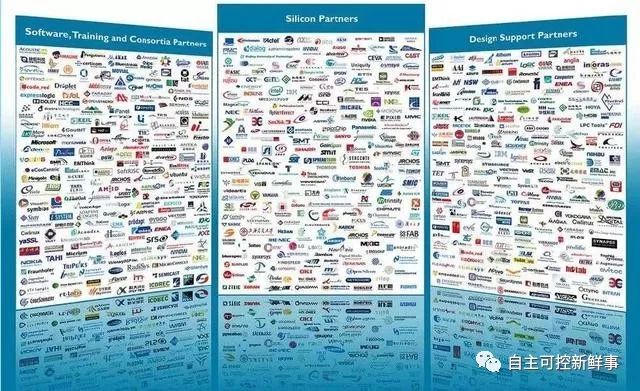 In the Chinese server market, ARM has established a complete set of industry chain partners based on server chips, including: KMI, Baao and other core virtual machine firmware manufacturers, Zhongke Fangde, Zhongbiao Qilin, Puhua and other operating system manufacturers, Ali Cloud, Huawei Cloud, Baidu Cloud and other cloud system partners, Dameng, Renmin University Jinchuang, Ruizhong Data, Shenzhou General, Nanda General and other database manufacturers, Dongfang Tong, Shandong Zhongchuang, Kingdee and other middleware manufacturers, as well as Inspur, Lenovo, Sugon, ZTE, Great Wall and other whole machine system manufacturers, forming a complete industrial ecosystem, enabling comprehensive domestic software.
Major Events of ARM in China:
Source: Self-Controlled Fresh News
Scan to Subscribe to the “Internet Information Military-Civil Integration” Magazine ↓↓↓
Important Note: Scan to subscribe to the magazine, invoices are issued by the postal office.
In the Chinese server market, ARM has established a complete set of industry chain partners based on server chips, including: KMI, Baao and other core virtual machine firmware manufacturers, Zhongke Fangde, Zhongbiao Qilin, Puhua and other operating system manufacturers, Ali Cloud, Huawei Cloud, Baidu Cloud and other cloud system partners, Dameng, Renmin University Jinchuang, Ruizhong Data, Shenzhou General, Nanda General and other database manufacturers, Dongfang Tong, Shandong Zhongchuang, Kingdee and other middleware manufacturers, as well as Inspur, Lenovo, Sugon, ZTE, Great Wall and other whole machine system manufacturers, forming a complete industrial ecosystem, enabling comprehensive domestic software.
Major Events of ARM in China:
Source: Self-Controlled Fresh News
Scan to Subscribe to the “Internet Information Military-Civil Integration” Magazine ↓↓↓
Important Note: Scan to subscribe to the magazine, invoices are issued by the postal office.









